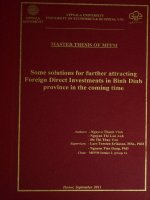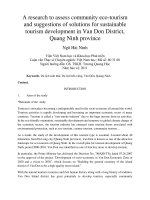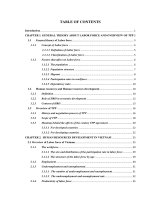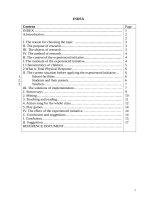Some solutions for human resource development in science and technology in Vietnam today
Bạn đang xem bản rút gọn của tài liệu. Xem và tải ngay bản đầy đủ của tài liệu tại đây (206.13 KB, 14 trang )
JSTPM Vol 4, No 1, 2015
73
SOME SOLUTIONS FOR HUMAN RESOURCE DEVELOPMENT
IN SCIENCE AND TECHNOLOGY IN VIETNAM TODAY
PhD Candidate. Nguyen Thanh Trung1
Department of Social and Natural Sciences,
Ministry of Science and Technology
Abstract:
Development of human resources in S&T management and in scientific research is an
integral part of human resource development for science and technology (S&T) activities.
From the limitation and inadequacy of the current S&T management mechanism, this
paper proposes four most important solutions for developing human resources in S&T, in
a basic and systematic manner, for the development of S&T of Vietnam.
Keywords: Human resources; Science management; Scientific research.
Code: 14092001
1. Introduction
Confronting the present trend of international integration, among those
factors determining the development of every nation, i.e, rich natural
resources, qualified human resources and developed S&T, the institutional
and human resources development increasingly become a decisive factor.
For Vietnam, in order to develop, the inevitable path to follow is to
renovate its growth model, restructure its economy towards improved
quality, efficiency and competitiveness. Therefore, Vietnam can only
choose and rely on S&T whereby human resources development in S&T
plays a decisive role.
This paper approached the issue from various limitations and inadequacies
of the current S&T management mechanism, and on that basis, proposed
some solutions for development of human resources in S&T activities - the
most significant and critical factor, it is critical to the development of the
S&T of Vietnam.
Some limitations and inadequacies of the current S&T management
mechanism have been mentioned in many published studies, namely:
Insufficient, weak, inadequate material-technical infrastructure for research
and development, investment in equipment without proper training on
operational skills for making full use of modern equipment purchased; Lack
of a master plan of developing S&T organizations by industry, sector,
1
The author’s contact is at
74
Some solutions for human resource development…
geography, it led to dispersed, overlapping and spread investment of
resources; Lack of strategic planning for training and retraining of S&T
manpower appropriate to each stage of development of the country and
international integration; Limited coordination, coherence between training
and scientific research; Weak coordination, collaboration in scientific
research between research institutions as well as between individuals
working in scientific research; Unattractive incentive policy including
inappropriate salary income for people working in scientific research
leading to lack of long-term commitment, low dedication to innovative
research career. In addition, the S&T management mechanism has been
running on administrative trend, scientific management agencies do the
work of scientists. In the process of implementing S&T tasks, management
agencies involved had overlapping functions with more and more
cumbersome administrative procedures set out.
2. Some solutions to develop human resources in science and
technology activities of Vietnam today
The issue of developing human resources, in a reasonable way, for research
and development and S&T management corresponding to the requirement
of industrialization and modernization of the country always requires a
system of comprehensive and synchronous solutions, from the policy
making stage to the practical implementation stage with mechanisms
consistent with the policies promulgated.
2.1. Raising awareness of stakeholders involved in the development of
human resources in science and technology
a) Objective of the solution
The development of human resources in general, and human resources in R&D
and S&T management, in particular can only be done through unified general
views of principle, from the determination of basic objectives to making a
system of specific policies needed to promote the synergy of the whole society
and the stakeholders engaged in the development of human resources. Thus,
the objective of the solution of raising awareness of the stakeholders involved
in the development of human resources in S&T is as follows:
First, to overcome the situation where there exists consistency between the
Party's resolutions, directives concerning S&T human resources
development and their proper implementation in practice. Resolutions,
directives may encounter drawbacks but they have not been thoroughly
considered and adjusted, leading to difficulties in enforcement, even nonapplicable status.
Practice shows that although the view and directive of the Party was
correct, the organization and enforcement of such policies depends much on
JSTPM Vol 4, No 1, 2015
75
thinking, perception and ability of leadership of different ministry, sector,
local and grassroots levels. It is therefore a requirement and necessary task
to raise awareness and undertake thorough implementation of the Party’s
views and policies on S&T human resources development.
Second, making the principles unified and specified in strategic
development plans at national, ministerial, local levels regarding S&T
human resources development in order for unified implementation from
central to grassroots levels, ensuring thorough absorption of the views and
policies issued by the Party. Some basic principles need to be specified are:
(1) views and orientations on developing human resources for R&D activities
and for S&T management; (2) guidelines for organization and implementation
in respect of human resource development for R&D activities and for S&T
management; (3) strategy for implementing the steps in human resource
development for R&D activities and for S&T management; (4) plan and
itinerary for elaborating policies in human resource development for R&D
activities and for S&T management (namely, training policy, challenge and
practical training, motivation policy, etc.).
b) Content of the solution
It should promote all forms of communication, education, training and
refreshment with a view to raising awareness of the Party and government
at all levels, as well as the whole society, for the implementation of the
Party’s directives and policies and the legal documents of the State with
regard to human resources development for R&D activities and for S&T
management, specifically:
First, it is necessary to have enough understanding to identify: (1) who are
researchers: it should be persons with scientific spirit, willing to sacrifice
their own desires to challenge difficulties in scientific works; persons who
work for non-economic purposes, dedicated to generate scientific results for
the sake of people and the mankind; persons having cooperation spirit in
scientific research; (2) what is scientific research: it is the innovative, highrisk work; it needs large investments; product of scientific research is the
outcome to bring about socio-economic benefits which have much higher
value compared to the cost spent for research; (3) who are science
management personnel: it should be qualified persons who understand the
characteristics of the objects under management, i.e, researchers working in
each sector; who can appreciate the value of science, are capable of
integration, cooperation and getting opinions from people working in
scientific research; (4) science management: is a scientific activity, so it
should be treated as a science; scientific management should be carried out
in the spirit of democracy, objectivity, creativity; scientific management is
the action undertaken in pursuant to the law, not dominated or imposed by
political power of privilege nature.
76
Some solutions for human resource development…
Second, the view of the Party in respect of the position and role of S&T
personnel must be thoroughly grasp and well aware of to achieve the
objective of industrialization, modernization of the country and its
development during the international integration period. Regarding the role
of S&T for socio-economic development of the country, it was indicated by
the Party: “Investment for S&T human resource is the investment for
sustainable development, directly raising the level of knowledge and power
of the nation” [1]. Law on S&T 2013 indicated that the State shall perform
policies to ensure that S&T development be the first national policy.
Regarding the role of S&T manpower, Resolution No. 27-NQ/TW dated
06th August 2008 adopted at the seventh Conference of the Party Central
Committee, X-th term, emphasised: “The Vietnamese intellectual cadre is
the creative labor force of particular importance in the process of
promoting industrialization, modernization and international integration of
the country, towards building a knowledge economy in Vietnam, developing
a Vietnam advanced culture with strong ethnic identity. Building a strong
intellectual cadre shall directly raise the level of intelligence, strength of
the country, improve the Party's leadership and the quality of the political
system performance. Investment in intellectual manpower is the investment
for sustainable development”. On the other hand, the resolution also
pointed out the responsibility of respective stakeholders in the S&T human
resources development in Vietnam presently: “The development of the
intellectual personnel is a common responsibility of the whole society, the
whole political system in which the Party and the State play a decisive role.
Intellectuals have the honor and duty before the country and the nation,
and should constantly strive to improve their political, ethical, professional
capacity in order to make largest contribution to the development of the
country and the national defense”.
Third, each stakeholder involved in the development of S&T human
resources, in their practical activities, should also clearly define their
responsibilities. This is expressed in the following:
- Each stakeholder involved in the development of S&T human resources
should be aware of, clearly define their responsibilities, and consider the
development of human resources for R&D and for S&T management as
an important work, an political strategic task which requires close
leadership and direction of the party, unified management of the state at
different levels;
- We should also be well aware that the focus on the development of S&T
human resources is placed on the development of policies relating to
detection, education, training, use of and incentives given to S&T
workforce, creating an enabling environment for them to promote their
creativity, dedication and intellectual energy for the development of the
JSTPM Vol 4, No 1, 2015
77
country. This is an indispensable subject of the organization and
management of human resources in S&T;
- We also need to have specific and practical actions to raise awareness of
the S&T manpower with respect to the implementation of the Party
directives and policies and the provisions of the State concerning
development of human resources in S&T. This will help us to overcome
the problem whereby promulgated policies are not properly implemented
in practice.
On the other hand, the S&T workforce itself also needs to understand and
define their position and role in the industrialization and modernization
process, to raise awareness by themselves of duty to serve the country and
people, tie up their scientific career with the S&T development of the
country; overcome shortcomings such as acquisitive title, power, profit and
lack of cooperation.
2.2. Develop and improve the capacity of personnel working in R&D and
S&T management to meet the requirement of industrialization and
modernization of the country
a) Objective of the solution
First, there should be a thorough implementation of the Party directive
considering "development and application of S&T is the first national
policy" and its viewpoint that “investment in S&T human resource is the
investment for sustainable development”. Therefore, human resources in
S&T should be taken into account at the national policy level and the
objectives set out should be for action.
Second, due to limited qualification and capacity of the present S&T
manpower which is still far from the requirement set forth by the
industrialization and modernization process, the objectives of this solution
towards developing human resources in S&T activities are: (1) S&T
personnel shall have the spirit of cooperation; (2) be fully capable of
performing national important and large scale S&T tasks assigned; (3)
shorten the present gap between generations of S&T personnel.
b) Content of the solutions
First, build up and improve the capacity of personnel working in R&D and
in S&T management through training and refreshment activities. Talking
about current status of capacity of S&T manpower of our country today, the
report submitted to the 6th Conference of the Central Committee, term XI
confirmed: “The gap between generations in research institutes,
universities continues to widen, the number of qualified S&T personnel
leading large S&T tasks decreased. No serious consideration has been
taken in the development and implementation of sector/local plans for S&T
78
Some solutions for human resource development…
human resource development” or ‘the spirit of cooperation and teamwork
skill of S&T personnel is not high, it is hard for the formation of strong
interdisciplinary research teams. Lack of cooperation between scientists
leading research teams, as a result, it made the content of S&T tasks
dispersed, without coordination between different research groups to
perform important and larger scale S&T tasks” [3, pp.20-21]. In the near
future, training activities for personnel working in S&T should be
conducted in direction of:
First of all, it should reform the mechanism of postgraduate training
towards clear definition of functions and their implementation between the
State and higher, postgraduate education establishments, between training
and retraining with the evaluation and degree recognition of the persons
trained. Higher, postgraduate education establishments perform the function
of training and retraining while the State delegates authority for them to
proactively make self-decision (on learning content, curriculum, criteria for
selecting subject matters, etc.), for postgraduate training and retraining
programs, on forming independent evaluation organizations and unified
implementation of the evaluation and diploma awarding functions,
recognition of master/doctorate degrees in the whole country associated
with each field of science. In this regard, the State must prescribe
orientations and general principles for such kind of training; prescribe
specific evaluation criteria in quantitative and clear manner. The State shall
conduct inspection and monitoring over the evaluation and the award of
degrees to ensure the quality of the training outputs; diversification of the
training modality of S&T human resources; focus should be placed on
strong research group training modality, in which there is close linkage
between training and scientific research and link with businesses.
The State should early promulgate related policies to link training tasks
with scientific research tasks; issue provisions regarding the share of at
least 10% of the total funding allocated for performing national, ministerial,
provincial level S&T tasks, for postgraduate training under the form of
paying research salary for trained person and became as member of the
research group.
The Ministry of Education and Training in collaboration with the Ministry
of Science and Technology (MOST) and line ministries concerned shall
organize graduate and post-graduate training for those who work in
scientific management; provide training and retraining for personnel
working in scientific research to ensure appropriate capacity structure (at
high, medium and low level) associated with the structure of the sector and
region. Focus should be put in training of highly qualified manpower in the
key S&T areas of high priority.
MOST shall be the host institutions to coordinate with related agencies and
JSTPM Vol 4, No 1, 2015
79
organizations to send capable, good conduct, promising managers and
scientific research staff for training abroad focusing on the subjects that the
country is in urgent need. This type of training will help scientific managers
and scientific research staff to gain knowledge of advanced management
and research methods from developed countries.
It shall promote the socialization in training to make full use of the potential
of social stakeholders in human resource development in scientific
management and R&D activities. In this respect, the State encourages and
creates favorable conditions for organizations and individuals who wish to
involve in funding for training and retraining of talented S&T personnel;
priority is given to attract, train S&T manpower for the region with difficult
and particularly difficult socio-economic conditions. This modality of
training will mobilize the potential of stakeholders in society including
businesses, NGOs, better-off individuals to participate in training activities
for S&T personnel.
Second, there should be diversified forms to practice, challenge, create
conditions for those involved in science management and research through
practical activities.
It should consider the challenge, practice provided in training for scientific
management and scientific research staff is a regular, continuous task to
improve the implementation capacity of personnel of concern in solving
practical problems of scientific management and scientific research work. It
should develop mechanisms and policies to provide challenge to personnel
receiving training in scientific management and scientific research by
assigning them with specific tasks together with favorable conditions for
implementation. It is considered as requirement for the management and
use of S&T human resources in our country today.
Annually, the agency in charge of management and use of human resources
in scientific management and scientific research also needs to organize
review activities to assess the performance of personnel who have realized
the scientific management and research tasks assigned for staff challenge as
well as assess the capacity of people working in scientific management and
scientific research.
The State should take compulsory and flexible measures for implementation
of the policy regarding rotating and transfer of personnel working in
scientific management and scientific research, in a reasonable manner and
in accordance with the capability and aspiration of the person concerned, to
ensure a stable and sustainable development of scientific management and
scientific research organizations.
Third, there should have the management of scientific workers reformed to
motivate those involved in scientific management and scientific research.
80
Some solutions for human resource development…
The scientific management reform is one of the important elements creating
motivation and creativity of people working in science. In this respect, we
should create a healthy research environment through scientific
management work: it needs to remove the regime of task assignment,
assignment based on seniority, use of personnel for all lifetime long; it
should base on the job description required to identify objectives, content
and the results of work to set up criteria for recruitment, appointment,
assignment and evaluation of the performance; based on the requirement of
the work to select and use appropriate persons, promote and appoint the
leader of the scientific management unit or the scientific research institution.
This is the outcome of the result based selection process of implementation
of the assigned task given during the training and testing exercise.
2.3. Innovation of management mechanism towards creating enabling
environment for human resources development in scientific research
activities
a) Objective of the solution
First, innovation of management mechanism has been general policy of the
Party and the State in recent years to promote the delegation of more
authority and implementation of mechanism of giving autonomy for S&T
institutions in order for maximum mobilization of resources for research,
simultaneously, freeing creative capacity of research personnel in S&T
organizations.
Secondly, scientific research is a particular kind of labor. It can only
develop in specific social conditions in which working environment and
management is extremely important. Due to limitations and shortcomings in
present operation of S&T, it is indispensable to create an environment for
the establishment of a synchronal and organized system of S&T as well as
the implementation of simplified administrative procedures in scientific
management to improve the efficiency in scientific research activities.
b) Content of the solution
First, to conduct reform of organization and operation in public S&T
institutions.
The government Decree No. 115/2005/ND-CP promulgated in September
2005 regarding the implementation of autonomy and self-responsibility in
public S&T organizations. There are some inadequacies when putting this
Decree into implementation, namely: "The transformation of public S&T
organizations to the mechanism of autonomy, self-responsibility” is still
slow, the efficiency of their operation after transformation is not high. The
main cause was the psychological inertia of dependence on the state
subsidies; lack of strong leadership of the host ministry and agency;
JSTPM Vol 4, No 1, 2015
81
perception of scientific workers, including leaders of public S&T
organizations about mechanism of autonomy, self-responsibility is limited;
lack of specific guidelines of the ministries concerned of the mechanism in
terms of reallocation of assets, land, loan borrow for production - business,
transfer of ownership of R&D results" [3, pp. 23-24].
In that context, it is necessary to continue to implement the policy of
reformed mechanism and operation in public S&T institutions towards
delegating autonomy to them in three aspects, as follows: Autonomy in
performing S&T tasks; autonomy in the organization, management and use
of personnel; autonomy in the use of funds and material infrastructure
provided by the State budget and generated by the S&T organization itself.
If it is well implemented, "It will really be an important breakthrough step
in the management of S&T, contributing to maximizing the research
capacity and creativity of organizations and individuals in carrying out
S&T tasks as well as gradually overcome the shortcomings inherent in the
current bureaucratic, cumbersome, multi-layer management system, which
has created major obstacles to the development of S&T” [4].
Second, innovation in the way of identification S&T tasks and assignment
of tasks for implementation.
The Law on Science and Technology was launched in 2000, since then the
management of science in our country has experienced many changes,
accordingly, the methods of identification and assignment of S&T tasks is
now formed in the direction of promoting higher role of institutions and
individuals and the community in the development of S&T. This is a
correct policy in line with the practical process of socio-economic
development. However, after a long time using the method of research
project identification based on proposals submitted by S&T
institutions/individuals or by order of the Party, State and ministries,
localities associated with method of selection, direct assignment of
institution/individual to perform the selected S&T tasks, there has revealed
some limitations, namely:
- Before the scientific research task is approved, most of the ideas
proposed by research institutions has been adjusted in the opinion of an
Advisory Council for research task identification and the scientific
management agencies concerned;
- Subsequently is the selection of organizations and individuals with the
best scientific capacity to perform S&T tasks. Thus, organizations and
individuals are to perform the tasks which may not necessarily come
from the research ideas of themselves. Accordingly, organizations and
individuals who have proposed the research idea may not necessarily
organizations and individuals who perform the approved research tasks.
82
Some solutions for human resource development…
With our present research environment, there is inevitably a tendency to
conduct research in a passive way (waiting for the research tasks assigned
by management agency, not from the practice of scientific work of
researchers). It is hard for researchers to proactively implement their
research ideas, partly because of limited resources, partly because their
research ideas were legalized for implementation by other organizations
and individuals (due to the nature of competition in the selection of research
tasks). It could be confirmed that the standard deviation in research was
going on in scientific research activities in our country. The basic function
of researchers is to develop scientific ideas, including those which have
been administratively used by the imposition of science management
agencies; organizations and individuals to perform research tasks are
usually not proactively prepared with all the necessary conditions to carry
out scientific research tasks assigned.
The consequence of the method of defining research tasks and selection or
direct assignment of implementing institution of approved research tasks
does not only limit the autonomy in research, but also produce negative
impacts or impede the creativity of personnel working in scientific research.
Researchers cannot be devoted to his research career because they must
spend a lot of time and unnecessary effort for settlement of administrative
procedures imposed by financial management agencies concerned and due
to weak capacity of management agencies. Therefore, the State should
change the method of defining research tasks and method of selection,
direct assignment of research institutions to perform scientific research, in
the following direction: Scientific management agency shall perform the
function of giving orientation for research and make it publicize in connection
with each research program/project; Organizations and individuals doing
scientific research with initiative shall determine by themselves the research
task according to their research capacity. The decision to award selected
tasks would be based on practical significance and potential application of
the expected results, the appropriateness and relevance of the proposal
expressed in the outline prepared and the research orientation announced by
the scientific management agency. Then, this agency with the assistance of its
scientific advisory board shall consider different aspects of the application,
namely the expected research results; implementation capacity of the
research group, etc. to select and approve the implementing entity of
research tasks.
The change of the selection method of organizations and individuals to
perform research tasks using the State budget from limited competition
between organizations and individuals having best implementation capacity
of an open, "no competition" nature is the outstanding point of the new
selection method. The advantage is the method of identification in the
research tasks linked with the selection of the implementing agent: (1) no
JSTPM Vol 4, No 1, 2015
83
limitation to individuals to participate in scientific research; (2) facilitating
people doing research work with conditions to create under their maximum
scientific capacity and qualifications; (3) researchers do not fear that their
research ideas be stolen; (4) creating a healthy environment for scientific
research development, overcoming the situation where research workers
become employed by some individuals who are not suitable for scientific
research, not leading scientists, but lead the research project; (5) helping the
simplification of administrative procedures in scientific management in all
stages related to the scientific advisory board (namely, tasks identification,
implementation agent selection and financial appraisal, etc.) thus can
shorten the time to review and approve the research project.
Third, it should promote the planning of network of S&T organizations
associated with the strategy for human resources development in scientific
research activities.
The issue of building a suitable network of S&T institutions is an important
factor in promoting the role of S&T human resources. To make this
possible, the State should issue a strategy for human resources development
in scientific research activities; integrate this strategy with the planning of
R&D system clustered by specific sector, region in order to concretize the
views and directives of human resources development in scientific research
for each period. The motto of human resources development in scientific
research for the time being is rejuvenated and practical. Rejuvenation and
practical is to help Vietnam have a team of young researchers with high
creativity, working for practical development of the country. The viewpoints
of human resources development in scientific research activities are: to aim
at the objective of industrialization and modernization for the development
of the country; to look out to the world for better integration with the S&T
movement and development of the world; S&T of Vietnam to catch-up and
reach in the near future, tentatively by 2030, a high ranking in the region
and an average ranking in the world. The strategy of human resource
development in scientific research should have a roadmap to follow and
complete a capacity structure with a logic human resources composition in
scientific research, and consistent with the planning of a R&D system
classified by industry/sector and by region.
In order to have a good planning of the network of S&T organizations, the
State should proceed to establish a system of uniform regulations necessary
for monitoring and evaluating the performance of individual researcher by
their contribution and their dedication to the development of science and
technology. To avoid brain drain, the State should have appropriate
mechanisms of consulting and introducing researchers to be used with
reasonable assignment commensurate with their talent, capacity and
advantage of their expertise in their S&T organization; create diversified
research trends, support the development of intensive research groups for
84
Some solutions for human resource development…
each different trend and school; emphasis should be placed on the
development of specialized research groups in which there is strong
cohesion, unity towards the creativity in new fields and topics of study.
2.4. Development of human resources in scientific management in
association with the development of science and technology
a) Objective of the solution
First, strengthen the capacity of personnel involved in S&T management to
implement the function of state administrative management and the
function of providing orientation for scientific research activities.
Second, building up a cadre of personnel with sufficient qualification and
good conduct to perform the function of scientific management, this cadre
should have knowledge and broad understanding of different fields of
science, and the spirit for the country construction and development.
b) Content of the solution
First, we need to review and revise policies towards the reform of organization
and personnel in scientific management in the following direction:
To enhance training and refreshment, building a cadre of scientific
management personnel capable of meeting the requirement of
industrialization and modernization. The plan of human resources
development for scientific management must be done based on the real
development of S&T. It should create conditions for staff to be equipped
with depth knowledge not only in management but also in the field of
science under their management. By this way, they can acquire appropriate
management practice and do not interfere in scientific activities.
To develop a master plan of establishing a system of scientific management
agents by sector and by region; determine the structure of scientific
managers linked with the plan of building the system of scientific
management agents by area, sector, and region; and create competency
standards of each job description corresponding to each position.
To facilitate scientific managers to perform their work, we also need to
conduct study to establish a system of standards on supervision and
independent evaluation of people working in scientific management and
scientific research activities. It should be done on a regular or ad-hoc basis,
the review and evaluation of the capacity of scientific management
personnel for the purpose of prepare plan of training, rotation, use of people
towards improved efficiency in the use of human resources in scientific
management at ministries, sectors and localities and regions in the country
as a whole.
JSTPM Vol 4, No 1, 2015
85
Second, to form a cadre of personnel working in scientific management
capable and qualified enough to become scientific managers.
Scientific management is also understood as a scientific activity. It requires
the people working in scientific management be capable of working in the
field of state management in general and in S&T management, in particular.
They are willing with passionate spirit to dedicate for the job of state
management; they are also person who commit themselves to and are
responsible for the development of S&T of the country. Therefore, it could
not select those who have no talent, lack of passion, willingness to work in
the career of scientific management in state scientific management agencies.
Scientific management requires not only the spirit of passion, love towards
state management career, but also the practical experience and knowledge
of scientific research activity. Criteria for evaluation and selection of
personnel to work in scientific management, first of all, the candidate must
be capable of performing scientific research tasks certified by specific
scientific works published.
Scientific management is considered as a scientific activity, it requires
stakeholders involved in the development of human resources for scientific
management must have an appropriate plan of action, starting from the
planning stage to working out implementation methods and monitoring and
evaluation. Therefore, attention should be paid, in a reasonable way, to the
stage of selection of personnel, task assignment so that it is appropriate to
their expertise and capacity for them to perform the management job well
and devoted themselves to each task assigned.
In order to have a workforce doing good job in scientific management, we
also need to pay attention to the needs, aspirations, psychological mood,
willingness of their own. It is very necessary to do this because it helps
them to focus more on the work, not to be distracted by pursuing their
acquisition of basic living and working needs, thus improve the quality of
scientific management tasks assigned.
3. Conclusions
From some limitations and inadequacies of the current S&T management
mechanism producing negative impacts on the development of human
resources in the system of scientific management and scientific research
institutions, this paper presented four solutions in human resources
development, out of which there were two solutions relating to reform of
mechanism: (1) reform of postgraduate training towards identification and
implementation of the following functions: training must be independent to
assessment and awarding diploma, and also independent to inspection of
the state; develop and diversify modality of training, whereby special
Some solutions for human resource development…
86
attention should be given to the training of strong research groups, linkage
of training with scientific research and with businesses. For post-graduate
training, it should extend the autonomy of training institutions at all stages,
build relationship between training institutions and learners under the
demand-supply principle of market while ensuring the quality of training by
controlling the current evaluation and diploma awarding process at
education establishments; (2) Reform of mechanism in scientific management
towards eliminating cumbersome administrative activities, not under the
function of scientific management agencies, eliminating mechanism of
S&T management by five-year plan and by fiscal year. It was supportive to
the views of continued implementation of mechanisms issued under Decree
No. 115/2005/ND-CP in respect of expanded autonomy and selfdetermination of public R&D organizations and individuals working in
research, proposed wage mechanism for scientific research personnel in
direction of linking the remuneration with specific S&T tasks.
The two other remaining solutions, i.e solution in respect of raising
awareness of the actors involved in the development of human resources for
scientific management and for R&D, the characteristics, role of S&T
human resources; and solutions regarding the content, methods of human
resources management in scientific management and in scientific research
activities, the responsibilities of each stakeholder in human resource
development in scientific management and for R&D activities./.
REFERENCES
1.
Resolution No. 20-NQ/TW dated 01st November 2012 of the Party’s Central
Committee, term XI on S&T development for the industrialization and modernization
in the condition of socialist oriented market economy and international integration.
2.
Resolution No. 46/NQ-CP of the Government dated 29th March 2013 issuing the
Action Program to implement the above Resolution No 20-NQ/TW.
3.
Government’s Party Committee. S&T development for the industrialization and
modernization in the condition of Socialist-oriented market economy and
international integration. Report submitted to the Meeting of Party’s Central
Committee, term XI, held in Hanoi on 18th September 2012.
4.
Dao Tien Khoa. (2012) Limitations, weaknesses and causes, problems of the current
S&T need to be settled - the mechanism of autonomy and self-responsibility of S&T
organization (Some thoughts of Decree No.115/2005/ND-CP). Thematic research
under the report for the Meeting of Party’s Central Committee, term XI, held in
Hanoi on 18th September 2012.
5.
Nguyen Thanh Trung. (2015) Development of Vietnamese manpower in scientific
management and scientific research for the development of S&T in the period of
accelerated industrialization and modernization of the country. PhD Thesis.









